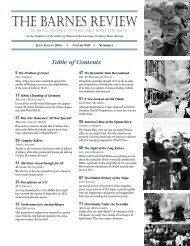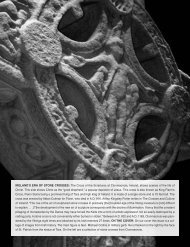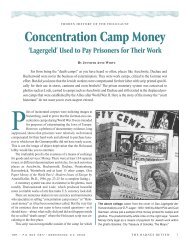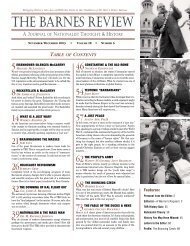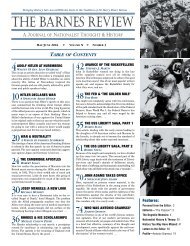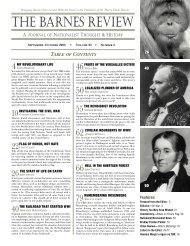You also want an ePaper? Increase the reach of your titles
YUMPU automatically turns print PDFs into web optimized ePapers that Google loves.
PAGE 36 the barnes review MAY/JUNE<br />
stein himself, and therefore Einstein has<br />
led people to believe that many of these<br />
ideas came to him in his sleep, out of the<br />
blue, because indeed that is the only logical<br />
explanation of how an admittedly inept fellow<br />
could have written such documents at<br />
the age of 26, without any real education.<br />
However, a simpler explanation exists:<br />
Einstein stole the ideas and plagiarized the<br />
papers.<br />
<strong>The</strong>refore, we will look at each of these<br />
ideas and discover the sources of them. It<br />
should be remembered that these ideas are<br />
presented by Einstein’s worshippers as<br />
totally new and completely different, each<br />
of which would change forever the landscape<br />
of science. <strong>The</strong>se four papers dealt<br />
with the following four ideas:<br />
(1) <strong>The</strong> foundation of the photon theory<br />
of light; (2) <strong>The</strong> equivalence of energy and<br />
mass; (3) <strong>The</strong> explanation of Brownian<br />
motion in liquids; (4) <strong>The</strong> special theory of<br />
relativity.<br />
Let us first look at the last of these theories,<br />
the theory of relativity. This is<br />
perhaps the most famous idea falsely<br />
attributed to Einstein. Specifically, this<br />
1905 paper dealt with what Einstein called<br />
the Special <strong>The</strong>ory of Relativity (the general<br />
theory would come in 1915). This theory<br />
contradicted the traditional Newtonian<br />
mechanics and was based upon two premises:<br />
(1) in the absence of acceleration, the<br />
laws of nature are the same for all<br />
observers; and (2) since the speed of light is<br />
independent of the motion of its source,<br />
then the time interval between two events<br />
is longer for an observer in whose frame of<br />
reference the events occur at different<br />
places than for an observer in whose frame<br />
of reference the events occur in the same<br />
place. This is basically the idea that time<br />
passes more slowly as one’s velocity ap -<br />
proaches the speed of light, relative to<br />
slower velocities where time would pass<br />
faster.<br />
This theory has been validated by modern<br />
experiments and is the basis for modern<br />
physics. But these two premises are far<br />
from being originally Einstein’s. First of all,<br />
the idea that the speed of light was a constant<br />
and was independent of the motion of<br />
its source was not Einstein’s at all, but was<br />
proposed by the Scottish scientist James<br />
Maxwell. Maxwell studied the phenomenon<br />
of light extensively and first proposed<br />
that it was electromagnetic in nature. He<br />
wrote an article to this effect for the 1878<br />
edition of the Encyclopedia Bri tan nica. His<br />
ideas prompted much debate, and by 1887,<br />
as a result of his work and the ensuing<br />
debate, the scientific community, particu-<br />
Throughout his early years, Einstein<br />
was an unknown outside of the narrow<br />
world of physics. But starting in<br />
1919 he became celebrated around<br />
the world. Einstein owed his sudden<br />
fame to the headline writers of newspapers<br />
in England and America. A<br />
world exhausted by war was eager<br />
for distractions, and the “bending of<br />
light” provided instantly beguiling<br />
slogans. As a wild-haired eccentric<br />
with a sense of humor and a rumpled<br />
charm, Einstein made for good<br />
newspaper copy.<br />
larly Hendrik Antoon Lor entz (1853-<br />
1928), Albert Abraham Michel son (1852-<br />
1931) and Edward Wil liams Mor ley<br />
(1838-1923), reached the conclusion that<br />
the velocity of light was independent of the<br />
velocity of the observer. Thus, this piece of<br />
the special theory of relativity was known<br />
27 years before Einstein wrote his paper.<br />
This debate over the nature of light also<br />
led Michelson and Morley to conduct an<br />
important experiment, the results of which<br />
could not be explained by Newtonian<br />
mechanics. <strong>The</strong>y observed a phenomenon<br />
caused by relativity but they did not understand<br />
relativity. <strong>The</strong>y had attempted to<br />
detect the motion of the earth through<br />
ether, which was a medium thought to be<br />
necessary for the propagation of light. In<br />
response to this problem, in 1889, the Irish<br />
physicist George Francis FitzGerald (1851-<br />
1901), who had also first proposed a mechanism<br />
for producing radio waves, wrote a<br />
paper which stated that the results of the<br />
Michelson-Morley experiment could be<br />
explained if “the length of material bodies<br />
changes, according as they are moving<br />
through the ether or across it, by an<br />
amount depending on the square of the<br />
ratio of their velocities to that of light.” This<br />
is the theory of relativity, 13 years before<br />
Einstein’s paper.<br />
Furthermore, in 1892, Lorentz, from the<br />
Netherlands, proposed the same solution<br />
and began to greatly expand the idea. All<br />
throughout the 1890s, both Lorentz and<br />
Fitz Gerald worked on these ideas and<br />
wrote articles strangely similar to Ein -<br />
stein’s special theory detailing what is now<br />
known as the Lorentz-FitzGerald contraction.<br />
In 1898, the Irishman Joseph Larmor<br />
wrote down equations explaining the<br />
Lorentz-FitzGerald contraction and its relativistic<br />
consequences, seven years before<br />
Einstein’s paper. By 1904, Lorentz transformations,<br />
the series of equations explaining<br />
relativity, were published by Lorentz.<br />
<strong>The</strong>y describe the increase of mass, the<br />
shortening of length, and the time dilation<br />
of a body moving at speeds close to the<br />
velocity of light. In short, by 1904, everything<br />
in Einstein’s paper regarding the<br />
special theory of relativity had already<br />
been published.<br />
<strong>The</strong> French mathematician and physicist<br />
Jules Henri Poincaré (April 29, 1854-<br />
July 12, 1912) had, in 1898, written a pa per<br />
unifying many of these ideas. He stated,<br />
seven years before Einstein’s paper, that:<br />
“[W]e have no direct intuition about the<br />
equality of two time intervals. <strong>The</strong> simultaneity<br />
of two events or the order of their<br />
succession, as well as the equality of two<br />
time intervals, must be defined in such a<br />
way that the statements of the natural<br />
laws be as simple as possible.”<br />
Anyone who has read Einstein’s 1905<br />
paper will immediately recognize the<br />
similarity. Thus we see that the only thing<br />
original about the Einstein paper was the<br />
term “special theory of relativity.” Every -<br />
thing else was plagiarized. Over the next<br />
few years, Poincaré became one of the most<br />
important lecturers and writers regarding<br />
relativity; but he never, in any of his papers<br />
or speeches, mentioned Albert Einstein.<br />
Thus, while Poincaré was busy bringing<br />
the rest of the academic world up to speed<br />
regarding relativity, Einstein was still<br />
working in the patent office in Bern, and no<br />
one in the academic community thought it<br />
necessary to give much credence or mention<br />
to Einstein’s work. Most of these early<br />
physicists knew he was a fraud.<br />
This brings us to the explanation of<br />
Brownian motion, the subject of another of<br />
Einstein’s 1905 papers. Brownian motion<br />
describes the irregular movement of a very<br />
small body (such as a grain of pollen suspended<br />
in water) arising from the thermal



